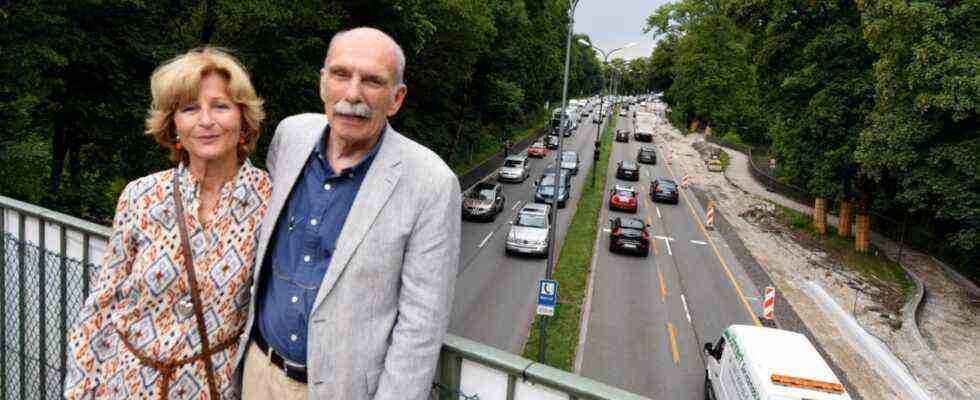When the city council voted unanimously for the reunification of the English Garden on June 28, 2017, there was great euphoria. Petra Lejeune and her husband Hermann Grub, the initiators of the project, were praised as the smallest but most successful citizens’ initiative that Munich has ever had Schmid (CSU) spoke of a “historic day”.
After setbacks due to unclear financing, the project had picked up speed again. When the Free State finally promised a contribution of 35 million euros for the project, which was estimated at 125 million euros at the time, nothing seemed to stand in the way of reunification. After all, the federal government classified this as a national urban development project and made 2.67 million euros available for the planning. Lejeune and Grub were there, it seemed. Then the building department took over the further planning – and dealt the project another, very serious blow in autumn 2021, if not the final knockout.
The city would have to pay 80 million euros itself
As it became known in November, according to the department’s calculations, 890 trees with a trunk circumference of more than 80 centimeters would have to be felled. That would be a lot of valuable greenery – too much for the taste of many city councillors. In addition, many see the high costs as no longer justifiable today. The city would have to pay 80 million euros itself.
No updated information is available on the total costs. But the tree problem, Lejeune and Grub fear, could prevent the green-red city council majority from initiating the planning approval process. “Then the project is dead for the next 100 years,” says Grub. Planning approval does not mean that construction will automatically have to take place later. It will take about three years for the building permit to be issued. After that it is valid for five years, until then the city could also have more money, according to the tunnel initiators.
The architect couple, who had not been involved in the planning of the project in the past four years and, as Grub says, “with a good feeling” handed it over to the building department, were shocked by the information provided by the authorities. That’s why the two have now become active again themselves, contacted the Bavarian Palaces and Lakes Administration and drew up a tree balance sheet on their own. Partly with material from the palace administration, partly through our own censuses. And after they took a closer look at the plans and compared them with the tree register, they came to the conclusion that instead of 890 large trees, only 368 would have to be felled. In the construction variant decided by the city council, there was still talk of 550 large trees.
“We have not been able to determine where and why 550 trees should still be felled”
Can Lejeune and Grub’s survey be correct? Are there really fewer trees instead of many more? Although both are architects, they are not civil engineering experts and tunnel planners, as they themselves admit. They didn’t want to make any claims either, they just wanted to ask how the building department got so many trees.
In doing so, they rely on several clues. For example this one: While the first plans envisaged an open construction, a so-called cover construction is now assumed, according to which diaphragm walls are first created on the sides and then a concrete cover, under which the tunnel is then dug. According to the expert opinion, some of the traffic could flow on the cover.
Before this cap is complete, eastbound traffic could be diverted to a dual carriageway on the south side of the ring. Today there is a bike path, a row of trees and a footpath. Grub estimates the width of the route to be eight to twelve meters, enough for two lanes. Oncoming traffic could then temporarily flow in two lanes on the old lane. The interventions in the English Garden would not be nearly as big. “Even after intensive research, we have not been able to determine where and why 550 trees are supposed to be felled,” Lejeune and Grub write in a statement.
Many questions remain unanswered for the tunnel initiators, and the building department refuses to meet
In their opinion, the logistics areas for the construction site could also be set up on free areas of the park, the construction road on the existing road profile between the construction site in the north and the construction site bypass on the south side of the ring. They also criticize the fact that in the tree inventory of the building department, the fellings for the renovation of the Kennedy Bridge and the Biederstein Tunnel are mixed up with the tree inventory of their tunnel project. “There are many unanswered questions,” says Petra Lejeune. However, the building department rejected a discussion with the aim of looking at the tree balance in a more differentiated way and stated in writing that this was not necessary.
Petra Lejeune and Hermann Grub want to keep fighting for their life project. Nine hectares of park would be restored in this way. On the homepage of the initiators a historical plan of the English Garden can be seen, although the park would no longer be quite as original with the tunnel. But for the most part, the wound torn in the landscape by car-friendly politics would be healed.

